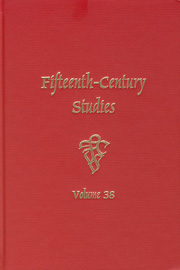Book contents
- Frontmatter
- Contents
- A Monastic Reformation of Domestic Space: Richard Whitford's Werke for Housholders
- Two Cultural Perspectives on the Battle of Lippa, Transylvania, 1551: Whose Victory Is It?
- Interpreting Sir Gawain and the Green Knight: Translation and Manipulation of Audience Expectations
- The Dry Tree Legend in Medieval Literature
- The Book of the Duke and Emperor: A New Edition and Interpretations within the Manuscript Context of MS. Manchester, Chetham's Library 8009 (Mun. A.6.31)
- Margery Kempe and the Spectatorship of Medieval Drama
- Wessel Gansfort, John Mombaer, and Medieval Technologies of the Self: Affective Meditation in a Fifteenth-Century Emotional Community
- Discerning Voices in the Trial of Joan of Arc and The Book of Margery Kempe
- Book Reviews
Wessel Gansfort, John Mombaer, and Medieval Technologies of the Self: Affective Meditation in a Fifteenth-Century Emotional Community
Published online by Cambridge University Press: 05 September 2013
- Frontmatter
- Contents
- A Monastic Reformation of Domestic Space: Richard Whitford's Werke for Housholders
- Two Cultural Perspectives on the Battle of Lippa, Transylvania, 1551: Whose Victory Is It?
- Interpreting Sir Gawain and the Green Knight: Translation and Manipulation of Audience Expectations
- The Dry Tree Legend in Medieval Literature
- The Book of the Duke and Emperor: A New Edition and Interpretations within the Manuscript Context of MS. Manchester, Chetham's Library 8009 (Mun. A.6.31)
- Margery Kempe and the Spectatorship of Medieval Drama
- Wessel Gansfort, John Mombaer, and Medieval Technologies of the Self: Affective Meditation in a Fifteenth-Century Emotional Community
- Discerning Voices in the Trial of Joan of Arc and The Book of Margery Kempe
- Book Reviews
Summary
Wessel Gansfort (c. 1419–1489), the fifteenth-century theologian, known by his contemporaries as the lux mundi, reported in his Tractatus de cohibendis cogitationibus (Treatise on Controlling Thoughts) on the value for meditants of exploring a range of emotional registers. Relaying an anecdote, Gansfort illustrated how he came to recognize the value of emotions during an incident unrelated to the act of contemplation. Being Frisian, Gansfort explained, he tended toward having feelings of near-constant gloom. Despite this glum proclivity, he noticed that his disposition altered substantially when he found himself in the company of river travelers who regaled him with tales of their adventures and engaged him in jocular conversation. These interactions with new friends momentarily lifted him from his depression, refreshing his spirit. Once those travelers departed, however, the theologian found himself returning to his original despair. This change in temperament aroused his curiosity. More than having been brought the emotional satisfaction of joy, he was struck by his capacity for self-alteration and began considering how a person might modify his or her own emotional state, not merely as a passing consequence of some external circumstance such as the company of new friends, but as an inducement toward permanent, self-directed transformation. He wished to restructure his inner self and believed that he could create this permanent change through the act of meditation. Emotions were for Gansfort a means of enhancing the process of meditation, of rendering its modifying effects truly permanent and worthwhile.
- Type
- Chapter
- Information
- Fifteenth-Century Studies 38 , pp. 153 - 174Publisher: Boydell & BrewerPrint publication year: 2013



